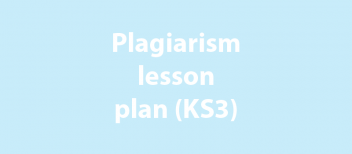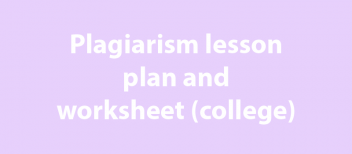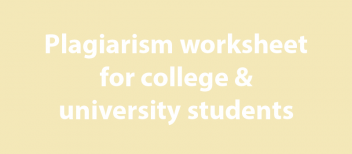Articles
See latest news and topics
Articles covering a range of topics on plagiarism, including famous plagiarism cases, plagiarism in the news and topics to help students.
Ask the Doctor
See guidance from our lecturer.
Guides prepared by a lecturer from one of the UK’s leading universities who has taught undergraduates, postgraduates, GCSE and A level students for 30+ years.
Lesson plans
Teach students about plagiarism.
Lesson plans for KS3, college and university students to help teachers tackle the subject of plagiarism.
Reviews
Compare plagiarism checkers
Read our honest, straightforward reviews of other online plagiarism checkers available.
Types of plagiarism
Learn more about plagiarism types.
There are many different forms of plagiarism. In this section, we look at the most common – some are obvious, others come as a surprise to many students!
FAQs
Find out more.
Read answers to frequently asked questions on using our AI detector and plagiarism checker software.
Plagiarism Articles
Articles covering a range of topics on plagiarism, including famous plagiarism cases, plagiarism in the news and topics to help students.
Summary: Plagiarism detection has evolved into a multifaceted research area at the intersection of text analysis, information retrieval, and natural language processing. The challenge stems from the diverse ways in…
Summary: Plagiarism remains a serious concern in academia and beyond. It not only includes verbatim copy-paste theft of text, but also disguised plagiarism such as paraphrasing, translating content from another…
Summary: Plagiarism detection is a critical concern in academia and publishing, and it traditionally relies on text-matching algorithms to find copied or paraphrased passages. However, conventional plagiarism checkers often struggle…
Summary: The most promising technical methods of plagiarism detection over the last 10 years combine deep learning, semantic analysis, and hybrid approaches to address increasingly sophisticated forms of plagiarism. 1….
Summary: Plagiarism detection is a crucial task in academia and content creation, traditionally addressed with methods like exact string matching and heuristic rules. However, these rule-based approaches struggle with nuanced…
Summary: Plagiarism detection aims to identify instances where an author has copied or closely imitated content from another source without proper attribution. In the digital age, vast amounts of textual…
Summary: Plagiarism is the unacknowledged reuse of someone else’s text, and it remains a serious challenge in academia and publishing. In the digital era, copying and rephrasing text has become…
Summary: Academic institutions broadly condemn plagiarism – the act of presenting someone else’s work as one’s own. However, attitudes towards plagiarism vary around the world. Educators often assume that all…
Summary: Plagiarism detection is the task of identifying instances where content has been inappropriately copied or imitated without proper attribution. Traditional plagiarism detection methods often rely on string matching or…
Summary: Plagiarism in doctoral research is a grave breach of academic integrity that can derail a PhD journey. It involves presenting someone else’s words, ideas or data as one’s own…
Ask the Doctor
Guides prepared by a lecturer from one of the UK’s leading universities who has taught undergraduates, postgraduates, GCSE and A level students for 30+ years.
Summary: Plagiarism detection has evolved into a multifaceted research area at the intersection of text analysis, information retrieval, and natural language processing. The challenge stems from the diverse ways in…
Summary: Plagiarism remains a serious concern in academia and beyond. It not only includes verbatim copy-paste theft of text, but also disguised plagiarism such as paraphrasing, translating content from another…
Summary: Plagiarism detection is a critical concern in academia and publishing, and it traditionally relies on text-matching algorithms to find copied or paraphrased passages. However, conventional plagiarism checkers often struggle…
Summary: The most promising technical methods of plagiarism detection over the last 10 years combine deep learning, semantic analysis, and hybrid approaches to address increasingly sophisticated forms of plagiarism. 1….
Summary: Plagiarism detection is a crucial task in academia and content creation, traditionally addressed with methods like exact string matching and heuristic rules. However, these rule-based approaches struggle with nuanced…
Summary: Plagiarism detection aims to identify instances where an author has copied or closely imitated content from another source without proper attribution. In the digital age, vast amounts of textual…
Summary: Plagiarism is the unacknowledged reuse of someone else’s text, and it remains a serious challenge in academia and publishing. In the digital era, copying and rephrasing text has become…
Summary: Academic institutions broadly condemn plagiarism – the act of presenting someone else’s work as one’s own. However, attitudes towards plagiarism vary around the world. Educators often assume that all…
Summary: Plagiarism detection is the task of identifying instances where content has been inappropriately copied or imitated without proper attribution. Traditional plagiarism detection methods often rely on string matching or…
Summary: Plagiarism in doctoral research is a grave breach of academic integrity that can derail a PhD journey. It involves presenting someone else’s words, ideas or data as one’s own…
Lesson Plans
Lesson plans for KS3, college and university students to help teachers tackle the subject of plagiarism.
Plagiarism lesson plan (KS3)
Free plagiarism lesson plan for use with KS3 children NB: For college/university, there are different resources available here. Year: KS3 Literacy | Topic: Plagiarism Learning Objective: Identifying correctly…
Plagiarism lesson plan and worksheet (college)
Plagiarism Powerpoint Presentation You can download the powerpoint presentation by clicking this link. You can access the worksheet here (including Word/PDF downloads) NB: For KS3, there is a different version…
Plagiarism worksheet for college and university level students
Download in WORD format | Download as PDF Plagiarism Worksheet for College and University Level Students Learning Objective: Identifying correctly and incorrectly cited information; identifying…
See all lesson plans & resources Get the free Workbook
Reviews
Summary: Plagiarism detection has evolved into a multifaceted research area at the intersection of text analysis, information retrieval, and natural language processing. The challenge stems from the diverse ways in…
Summary: Plagiarism remains a serious concern in academia and beyond. It not only includes verbatim copy-paste theft of text, but also disguised plagiarism such as paraphrasing, translating content from another…
Summary: Plagiarism detection is a critical concern in academia and publishing, and it traditionally relies on text-matching algorithms to find copied or paraphrased passages. However, conventional plagiarism checkers often struggle…
Summary: The most promising technical methods of plagiarism detection over the last 10 years combine deep learning, semantic analysis, and hybrid approaches to address increasingly sophisticated forms of plagiarism. 1….
Summary: Plagiarism detection is a crucial task in academia and content creation, traditionally addressed with methods like exact string matching and heuristic rules. However, these rule-based approaches struggle with nuanced…
Summary: Plagiarism detection aims to identify instances where an author has copied or closely imitated content from another source without proper attribution. In the digital age, vast amounts of textual…
Summary: Plagiarism is the unacknowledged reuse of someone else’s text, and it remains a serious challenge in academia and publishing. In the digital era, copying and rephrasing text has become…
Summary: Academic institutions broadly condemn plagiarism – the act of presenting someone else’s work as one’s own. However, attitudes towards plagiarism vary around the world. Educators often assume that all…
Summary: Plagiarism detection is the task of identifying instances where content has been inappropriately copied or imitated without proper attribution. Traditional plagiarism detection methods often rely on string matching or…
Summary: Plagiarism in doctoral research is a grave breach of academic integrity that can derail a PhD journey. It involves presenting someone else’s words, ideas or data as one’s own…
Types of Plagiarism
Plagiarism vs. détournement
Find out about the difference between plagiarism and détournement The concept of détournement has been part of our culture for almost 100 years, having its roots in the Dada art…
Plagiarism vs homage
Find out about the differences between plagiarism and homage They say that imitation is the sincerest form of flattery. This then begs the question of when does flattery cross the…
Plagiarism vs. parody
Find out the differences between plagiarism and parody The dangers of plagiarism are some of the most important lessons that media creators can ever learn. As defined by Merriam Webster,…






